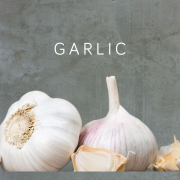Garlic
Garlic is one of the most prolific flavouring agents in the culinary world and there is seldom a savoury dish that does not contain even a hint of garlic in it. Garlic has also been a mainstay in the medicinal arena for over 10 000 years. But here’s a question I bet will create a little debate…
WHAT IS IT?
Is it a herb, a spice, a vegetable? The answer to that depends where you are looking. Botanical literature often refers to it as a bulb or vegetable. Pick up any spice or herb book and you are sure to find it listed. And so the debate continues without any clear answer. As a self confessed garlic fanatic it is both a vegetable and spice to me. In powder form it is an essential spice for many dishes, in its whole form it is a potent vegetable that I use whole, sliced or diced.
The botanical name for garlic is Allium sativum, which basically means cultivated (sativum) garlic (allium). It belongs to the Alliaceae family or onion family that also includes onions, shallots, chives, leeks and ornamental alliums. The Alliaceae family has over 750 species which include some of the more well known and used onions, leeks, shallots and chives. There is another category called ornamental alliums and according to botanists are theoretically edible.
WHERE DID IT COME FROM?
Garlic as we know it today originated in Central Asia, but features in many cultures across the planet. As the centuries passed cultures adopted garlic as being a powerful ingredient that was used for everything from treating an array of ailments in Egypt to giving Roman soldiers strength to warding of vampires in Slovakia. As at 2020 Asian countries exported almost 70% of the worlds garlic with Spain coming in second at just over 15%.
Without garlic I simply would not care to live
Louis Diat, Chef & Culinary Writer (1855 – 1957)
WHAT DOES IT SMELL AND TASTE LIKE?
Garlic has a very distinct flavour and aroma thanks to a powerful flavonoids has an array of tastes in different forms. Eaten raw it gives off a mustardy, tangy and musky flavour. When roasted or sautéed the flavour remains strong but gains a sweeter and gentler flavour profile. There are a few flavonoids at play with the main characters being allyl alcohol, diallyl disulfide, methyl allyl disulfide, and methyl allyl trisulfide.
The smell can be quite pungent with a sulphur like undertone. This sulphur smell and sharp taste can be very off-putting for some and for others (like me), get the digestive juices going at the delectable and distinctive smell.
HOW TO IDENTIFY, STORE AND PRESERVE
Types of Garlic
Depending on where you are shopping you might only have access to limited types of garlic. Here are a few titbits to help you identify which garlic you are using:
- The smaller the bulb the stronger the taste
- The most common garlic found in the store is softneck garlic with the silverskin variety being the most popular
- Silverskin garlic can be identified as white or pinkish cloves with 8 – 30 cloves per bulb
- Cloves are the individual segments that collectively make up a bulb
- Giant garlic bulbs are most likely Elephant Garlic
- Elephant garlic is more closely related to leeks than garlic, making their flavour more mild and creamy
- Solo garlic aka pearl garlic or single clove garlic has been genetically engineered to grow as a single clove. It is easier to peel and chop due to its size, but the flavour is mild
Buying and Storing
Fresh bulbs are always best for flavour and potency, however garlic, if stored correctly, can last for a fairly long time:
- Bulbs should be firm and round with clear papery skins
- Avoid ones with green sprouts or brown aging spots
- Cool, moist conditions like the fridge stimulates sprouting
- Store uncovered or loosely covered in a dark dry place
- Avoid paper or plastic and rather opt for storage with ventilation like a net bag
- A dark environment will help prevent sprouting and drying out
- Homemade crushed or minced garlic can be kept in the fridge for up to a week
- Green sprouts are bitter and should be removed before using the clove
- Individual cloves should be used withing 1 – 10 days
- Whole bulbs can be kept for 1 – 8 months depending on storage conditions
Preserving Garlic
Garlic can be preserved in a number of ways. How long each method can be stored for depends on how fresh the product was to begin with. As a rule always remember to label and date your batches and use the oldest batch first.
DRIED – Bulbs can dry out naturally over a number of months or be put in a dehydrator/oven to speed up the process.
FROZEN – Peeled whole or chopped cloves are placed in a freezer bag and frozen (texture will be affected). Another alternative is to add minced cloves to oil and pour into an ice cube tray and freeze the use as needed.
JUICE – Garlic juice can be portioned out and frozen in ice cube trays, then used as needed.
OIL – Infusing garlic into oil not only allows for preservation, but has the added bonus of a flavourful oil that can be used for cooking and salad dressing.
FERMENTED – Fermenting garlic in honey is not only delicious but fantastic for gut health.
CULINARY USES
- Fresh Garlic – Whole bulbs or loose cloves are used as needed
- Roasted Garlic – Roasted and then either blended into a dish or paste
- Garlic Powder – ½ tsp = 2 cloves of fresh garlic. The flavour is a lot milder than fresh garlic and has a lower nutrient yield.
- Dehydrated Garlic – More commonly sold as garlic flakes or chips.
- Garlic Salt – Often confused with Garlic Powder. It is around 80% salt and the remaining 20% is garlic powder and anti clumping agents.
- Garlic Paste – Made by roasting garlic and then blending into a smooth paste. Commercial pastes may contain preservatives and garlic powder.
- Crushed or Minced Garlic – Can be bought plain or in oil and will most likely contain some acidic preservative.
- Garlic Oil – Oil infused using a mild heat to release the flavour.
- Black Garlic – aged (not fermented) garlic that turns black or deep brown over time.
Used Raw
Garlic can be used raw in many dishes and adds a tangy sharp flavour. Dishes include:
- Butters, spreads, hummus and dips
- Salad dressings, sauces, pesto’s and paste’s
- Salsas and salads
Used Cooked
Garlic contains many compounds that add rich and more mellow flavours, especially when cooked. Ways to include garlic in a dish are:
- Roasted garlic in mashed potatoes, veggies, grains or beans
- Minced, whole, sliced or diced garlic in sauces, stews and bakes
- Off cuts and skins can be added to broths
- Flavouring rice’s and grains
- Add to soups, and hot sauces
MEDICINAL USES
Over the ages garlic has often been touted as a panacea, but as science has evolved so has our understanding of this tasty powerhouse. It is so well know for its flavour profile that we often overlook its nutritional value. Garlic is rich in Vitamin B6, minerals and potent sulphur (sulfur .us) compounds also known as volatile factors.
Studies have shown garlic extract specific antimicrobial properties in some instances. Some studies have shown garlic to help recover and lower risk of getting the common cold and most interestingly are the proposed benefits for cardiovascular health (CVD). With studies shown a marked improvement in lowering cholesterol. Further studies are still to be done to ascertain the preparation and dosage required for medicinal value. In regular speak that means there is potential, but there isn’t clarity as to how much and in what form (dried, isolated, extracts etc.) are the best source.
But until the science catches up it cannot be disputed that garlic is a not only a delicious addition, but also a nutritious addition to a healthy diet.
TIPS AND TRICKS
- Avoid cooking over 180°C / 350°F as garlic will begin to taste bitter
- Chopping, crushing or mincing garlic releases allicin
- To get maximum allicin released, prep your garlic first then leave for at least a minute
- Once you break up the bulb the shelf life is greatly reduced
- To remove the garlic smell from your hands, rub your hands on a stainless steel sink or spoon under running water



